In every era, there is always some form of mass entertainment masquerading as news or true stories. Today we have reality TV and endless forms on the internet. In the 1950s, there were at least three “true crime” magazines that carried the ‘story’ of Ervin’s murder. Each of them sensationalized the story to a certain degree, some more than others. They all re-arranged the sequence of exactly what happened (in order to make a better story for their readers), made up dialog they couldn’t possibly have known (as if they had been in the room while the police were interrogating people), and sometimes just got the facts wrong. So, the stories in these magazines should be read with that in mind. These should be the last resort for information about the murder and thrown out entirely when they contradict the police reports.
With that said, here’s the first of them: Official Detective Stories from the August 1955 issue. This would have been written in early June of 1955, as Cap Oveross was returned from Alaska in the very last days of May, and the trial started just over three weeks later, June 21, and this magazine story ends with Oveross awaiting trial. Magazines are generally “post-dated” by about 2-3 months in an effort to keep them on the newsstands longer, so this issue would have appeared in either June or very early July 1955.
The cover is apparently the east-coast publisher’s idea of what shoplifting in Mexico looked like: let’s throw in a few pots and baskets, a few seemingly Mexican wraps or blankets, what looks like a businessman in a poor-man’s Halloween costume, and what appears to be a Doris Day want-to-be as a southern senorita. I guess they didn’t have much of a budget for their cover art…
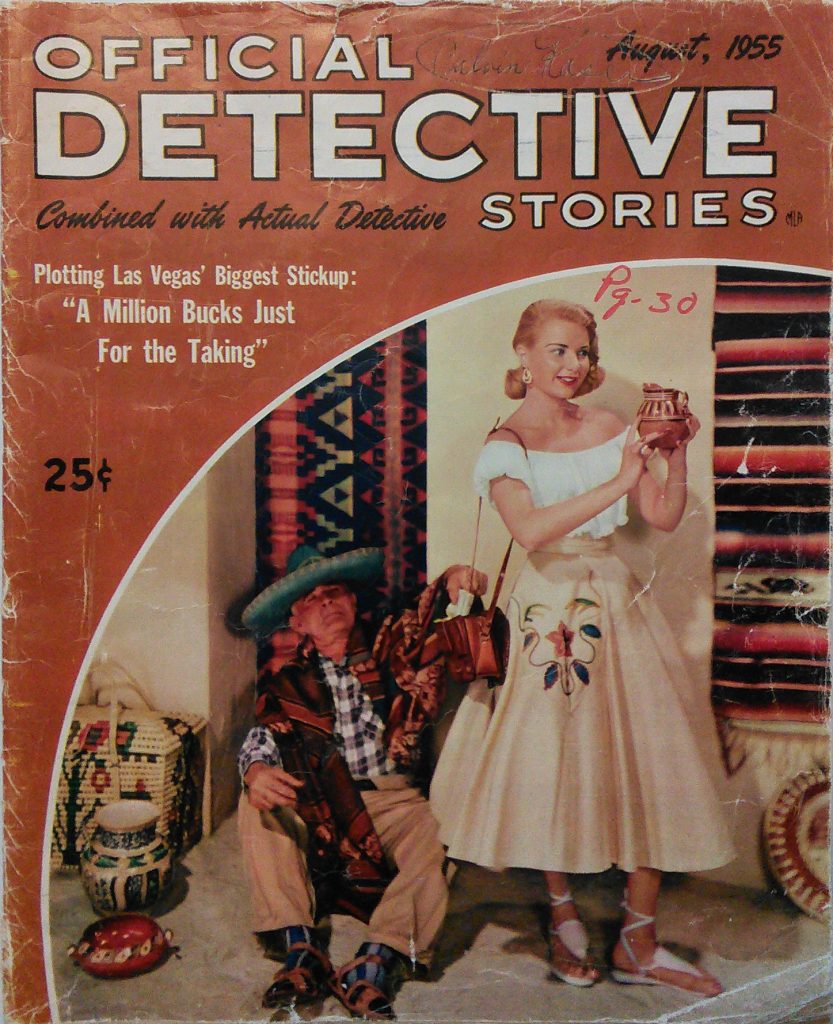
Official Detective Stories – August 1955
“Me, I Shoot. Anything Wrong With That?”
Ervin Kaser “Associated with Other Women” the Bill of Particulars Said. Who Could These “Women” Be? Was This Connected With His Slaying From Ambush Near Silverton, Oregon?
The first shot brought Emanuel Kellerhal upright in his bed. He and his wife had retired at 10:30 Thursday evening, February 17, 1955. It was now 25 minutes later.
The second shot took him to the window, where he could see across the highway to the ranch home of his neighbor, Ervin O. Kaser.
A pair of headlights illuminated the driveway, garage and front of the Kaser house.
The third and fourth shots exploded and Kellerhal could see the dirty orange flame of the blasts, for they were fired just beyond his window from a car parked in his own driveway.
A car motor roared. Tires whined and there was a hailstone sound of gravel being thrown by the spinning wheels. And then the silence of night that comes to those who enjoy the seclusion of country living.
The Kellerhal and Kaser hop-growing ranches are in the rural district of Evergreen, three miles south of Silverton, Oregon.
“What is it?” Mrs. Kellerhal asked.
“I don’t know,” her husband answered, still peering out of the window. “I can see Kaser’s car in his driveway. Somebody must have been shooting at him.”
“Shooting at Mr. Kaser? Why?”
Kellerhal turned away from the window and picked up his trousers.
“What are you going to do?” his wife demanded.
“I’d better get over there and see what’s the matter. Nobody’s moving around. Maybe Kaser was hit.”
“Please don’t,” Mrs. Kellerhal said. “Call the police.”
“You call them.”
“No, you call. It’s their business. Please stay here until they arrive. If some fool is shooting out there –”
“They’ve gone. I saw them leave.”
“It makes no difference. Call the police and we’ll wait.”
Silverton Marshal Harley DePeel was the first to arrive. He was followed shortly by Marion County Deputy Sheriff R. C. Boehringer. Within a few minutes more sheriff’scars and State Police rushed into the area.
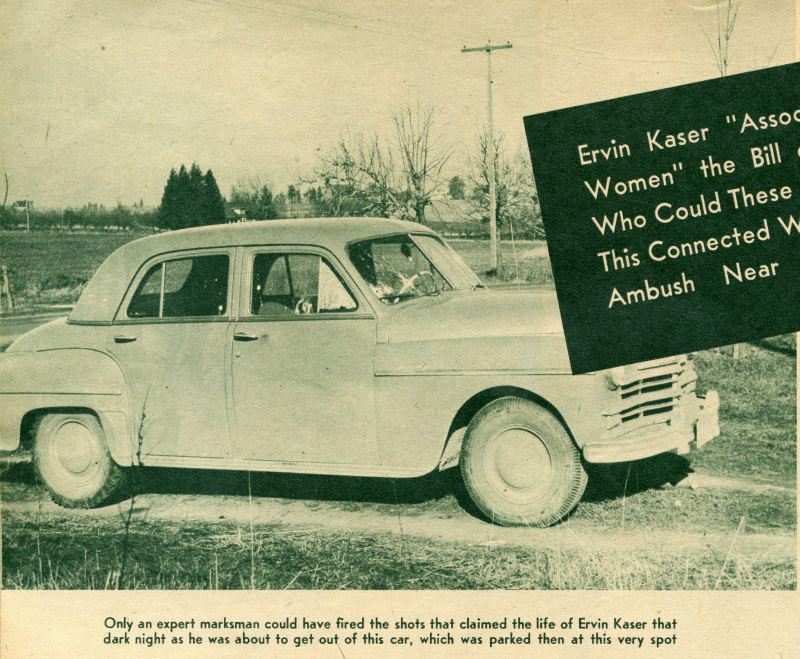
The Plymouth sedan owned by Kaser was parked almost beside the front door of his neat, nearly new white frame cottage. Its motor was stopped but the headlights and the dome light inside the car were burning.
Kaser was slumped on the right side of the front seat. Blood had spilled onto the floor mat.
A hole was drilled through the glass of the front door on the left side of the car. It probably had been made by a shot that had struck Kaser in the shoulder and penetrated his heart, killing him instantly.
Three other holes made a tight pattern in the frame of the front door, the post and the forward edge of the rear door.
Boehringer eyed the 75-yard distance across the front yard and the highway to the spot where Kellerhal said he had seen the other car. “Whoever he was, he was a marksman,” the deputy said. “That kind of shooting would win a medal on a target range.”
Kellerhal was questioned. He could not name the make of the car he had seen. “All I can be sure of is that it was a dark color. Maybe it was a Ford, but I couldn’t be certain.”
And he had not seen the killer, nor anyone else in the automobile. “Its lights were off and I didn’t notice it until I heard the third and fourth shots. I was looking over at Kaser’s place. Then this other car sped away.”
“How long after the shots?”
“Right away.”
“There wasn’t any pause?”
State Police Patrolman Robert Dunn was trying to determine if enough time had elapsed for the person who fired the shot to put down the gun and then start the car.
“It didn’t seem like any time at all.”
“Then two persons must have been in the car,” Dunn surmised. He radioed State PoliceHeadquarters and asked for a road block around the area. All cars would be stopped and their occupants questioned. The officers would search each automobile for the gun that had been used in the slaying.
Why had Kaser been ambushed?
The police officers readily realized that the killing had not been motivated by robbery. This was something personal between the victim and his slayer.
No attempt had been made to burglarize Kaser’s house or rob his person. The killer had fired the shots with the sole purpose of getting Kaser.
Kellerhal could tell the officers little about his neighbor, although Kaser had lived in the area all of his life. About four years previously, he had built his home, where he, his wife and a step-daughter had lived.
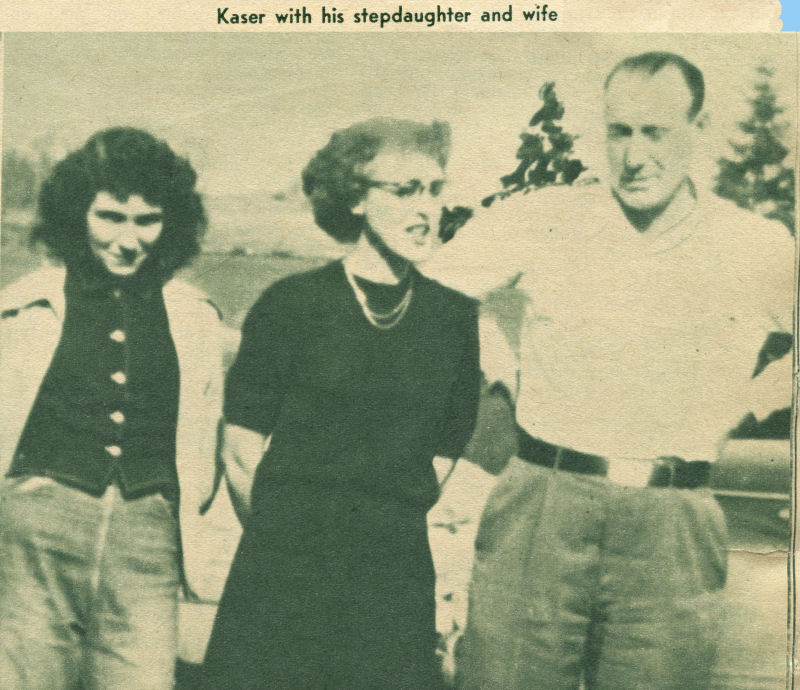
“His wife and daughter moved out about six months ago,” Kellerhal said. “We understand Mrs. Kaser is getting a divorce. I think she’s staying in Salem with the daughter who’s been married since.”
“Has Kaser been living here alone?”
“Yes.”
“What about the divorce?”
Kellerhal said he and Kaser never had been on intimate-enough terms to discuss the dead man’s private life. Although most farm families in the district were close and visited one another frequently, the Kasers had remained aloof from the community.
“Since his wife’s been gone,we’ve seen some men there at nights. We guessed maybe they were having a poker party. I’ve heard talk that Kaser liked to gamble.”
This could be a motive. The officers quickly seized upon it to ask more questions. They wanted to know if Kellerhal had recognized any of the men who had come to the house in the evening.
Kellerhal said that while he had paid no particular attention to the visitors at Kaser’s house and the men usually arrived after dark, he was almost certain they were not residents of the community. “Otherwise, we’d have heard talk.”
“How about the cars? Do you recall any in particular?”
Kellerhal could give no help on this point either.
About this time, Sheriff Denver Young and State Police Sergeant Wayne Huffman arrived on the scene. They examined Kaser’s car without disturbing the interior for Doctor Homer Harris, a pathologist, and Ralph Prouty, a criminologist with the State Police Crime Laboratory, were on their way.
Of the four shots that had entered the side of the car, two had gone out through the front windshield. One had struck the windshield and lay spent on the floor. The fourth was in Kaser’s body.
Sheriff Young directed a search for the two slugs that had gone through the windshield. A second search was started for any shell casings at the place where Kellerhal had seen the bullets fired.
However, no casings were found. Either the slayer had used a gun that did not eject its empty shells or he had fired from inside a car and the ejected shell casings were still in his auto.
Inside Kaser’s car was a sack of groceries on the back seat and the dead man clutched a carton of cigarets in one hand.
Apparently Kaser had turned on the dome light of his car and slid over to the right side of the front seat, preparatory to lifting the sack of groceries, when he was shot. The light inside the car had given the slayer an illuminated target.
Sheriff Young wanted the answer to one question right away. Had the killer been waiting in ambush for Kaser to return home, or had he followed Kaser’s car?
To the Sheriff, the answer meant a difference in the theories that could be formed for a motive.
Anyone planning the crime in advance, which would indicate a motive of long standing like a grudge, would have known where Kaser lived and his habits. He could have waited for Kaser to come home.
But if Kaser had been followed, then the motive might be a spur-of-the-moment decision, based on something that had happened during the evening. The slayer could have followed him from wherever he had been during the evening and used the first opportunity to send home the lethal slug.
Kellerhal had said that he heard Kaser’s car turn into the driveway across the highway and had heard the second car follow it within a few moments.
“I though the people in the second car also had gone into Kaser’s place,” Kellerhal said. “I remember thinking at the moment that Kaser probably was going to have another of his poker parties.”
Doctor Harris and Prouty arrived during this questioning. They recovered the spent slug inside the car and Prouty examined it carefully.
“I’d guess it to be about a thirty-caliber rifle slug,” he said. “It’s pretty badly mushroomed, but we may find enough land and groove marks on it to identify the gun if it can be located. We’ll also have a chance from the slug in the body.”
Photographs were made of the scene. The officers went over the area where the killer’s car had been parked in hopes of obtaining imprints of the tires but the graveled surface foiled this attempt.
A few minutes later Marshal DePeel came up to Sheriff Young and Huffman with some information. “I’ve been canvassing at the edge of town,” he said, “and I heard that two fellows who live out on this road left town at about the time that would bring them past here when the shooting took place. They are Ray Jackson and Fred Barto.”
“Do you know anything about either of them? Anything that might connect them to a feud with Kaser?”
“I know both of them. They’re nice fellows with families. We can go out and talk to them and then, on the way back, I guess we’d better notify Kaser’s relatives, his brother and his mother.”
Kaser’s brother, Harvey, had a ranch about a half mile down the road. His mother also lived near by on the old family farm. Kaser’s father, who had passed away, had been one of the pioneers in the section. Two other brothers also lived in the area; a fourth brother lived in Bay City and a sister in Salem.
“The Kasers are a fine old family in this section,” DePeel said. “Folks aren’t going to take it kindly that Ervin has been killed.”
“It’s a break that he’s an old-timer,” Huffman said. “Maybe from all the friends and relatives we can come up with a motive.”
The officers went to see Ray Jackson first. The young farmer was already in bed. Barefooted and in his nightshirt, he invited the officers inside, expressing shock at the news that Kaser had been slain.
“What time did you get home?” Huffman asked.
“Ten fifty-five exactly,” Jackson declared.
Huffman’s eyes narrowed at the answer. Kaser had been killed at exactly 10:55, according to Kellerhal.
“How are you so sure of the exact time?”
“I looked at the clock when I came in.”
“Where were you tonight?”
“At the wrestling matches.”
DePeel said: “They weren’t over by that time. I was at the matches when I got the call Kaser had been shot.”
“I know. But I promised my wife I’d be home by eleven and I left before they were finished.”
Jackson claimed that he had seen nothing unusual along the highway on this way home and had not noticed any cars parked at Kaser’s place as he went by. If his story were true – and the officers had nothing to disprove it –he must have passed before Kaser and his slayer had arrived.
At the Fred Barto ranch, Barto told the officers that he had seen Kaser’s car parked in the driveway at the time he had gone past.
“I saw the headlights and slowed down, thinking he might be backing out,” Barto declared. “But the car was standing still so I went on by.”
Kellerhal had told the officers that he had not heard any other cars come down the highway after the slayer’s machine had left. But he might have been telephoning at the time Barto had passed, or Barto might have scooted by before the shooting.
Someone already had telephoned Harvey Kaser with the news that his brother had been killed when the officers reached his home and Harvey was getting ready to leave.
He drove to the scene with the officers while Huffman and Young questioned him. He claimed he knew of no reason for anyone to kill his brother.
Questioned about the divorce, Harvey said the only dispute still involved in the separation of his brother and sister-in-law was over a property settlement.
“Their marriage just didn’t work out,” Harvey declared.
Pressed for any other possible motives, Harvey recalled that his brother had been involved in a dispute with a bulldozer operator who had done some work on the ranch.
“This man didn’t do the job the way Ervin wanted it done and Ervin said he wouldn’t pay him unless he did it over. The guy refused and threatened to sue Ervin,”Harvey said. “I heard he threatened to punch in Ervin’s head.”
The man was Sam Lord, a contractor of Salem, the state capital, only fifteen miles from Silverton.
Huffman radioed State Patrol Headquarters in Salem to have Sam Lord questioned at once to determine the man’s movements during the evening.
Harvey was asked about the poker parties at his brother’s home.
“Ervin liked to play cards, but the stakes weren’t big,” he replied. “I doubt if that could have anything to do with this. All the fellows he played with were his friends.”
Harvey gave the officers the names of a number of the players. They would be questioned later to determine if any quarrel had developed as the result of the card games.
Back at the scene, Docter Harris and Prouty had concluded their investigation of the physical evidence and had the victim removed from the car. With Harvey’s permission,the body was taken to a mortuary in Salem where an autopsy would be performed in the morning.
The road blocks around the Evergreen area were maintained throughout the night and although several hundred cars were stopped and searched and the occupants questioned, no one was found who could be considered a suspect in the slaying.
One lead was reported by a motorist who said he had seen a dark Ford sedan speed through a stop sign at the Paradise Alley intersection on the way to Silverton at about ten minutes after the slaying. It might have been the fleeing killer but the motorist had been unable to get the license number and no further trace of the car could be found.
At a conference in the morning, after working through the entire night, Sheriff Young, Deputy Amos Shaw, Sergeant Huffman, Patrolmen Lloyd Riegel, Stan Barron and Robert Dunn, and District Attorney Kenneth E. Brown formed plans for continuing the investigation.
“The case amounts to this,” Huffman declared. “Kaser was killed by somebody who had a pretty strong motive. You don’t follow a man and mow him down with a rifle unless you’ve worked up a big hate.”
The others agreed. But how find the motive? How solve the killings?
“There are enough riflings on the slugs to identify the death weapon,” Prouty said. “Find the motive and that will give you the killer. The gun will be the evidence to convict him.”
It was that simple.
But where to start?
The report from Salem on Sam Lord was negative to the extent that police had been unable to find the man. He had left on a job three days previously. Friends thought he had taken his equipment to The Dalles area but did not know the exact location.
A rumor came in to the officers that despite Fred Barto’s statement that he and Kaser had been on friendly terms, the men had quarreled over marketing their crop the previous Fall.
Barto had no alibi from the time he had left Silverton until he had reached his ranch. By his own admission, he must have passed Kaser’s house around the time of the slaying.
Deputies were assigned to investigate further on the rumor. Two rifles owned by Barto were brought in to be tested by ballistics experts at the State Crime Laboratory.
The pending divorce between the slain man and his wife was examined to determine if it could hold a clue to the motive. The charges and counter-charges were examined.
They found the complaint by Mrs.Mary Louisa Kaser charged her husband with cruel and inhuman treatment, staying out all night on occasions and sometimes remaining away from home for days without explanation. She further charged that he had failed to support her, refused to buy food or clothing for her, refused to associate with her friends and locked her and her daughter out of their home.
The charges also declared that Kaser had associated with other women and had refused to speak to her, refused to share information about family finances and had struck and beat her.
Mrs. Kaser requested an undivided half interest in his property or a cash settlement of $15,000.
In his answer to the suit, Kaser had denied all of his wife’s charges.
The action had been started on August 6, 1954, and was scheduled to be heard in court on March 17,1955.
The officers drove to Salem, where Mrs. Kaser was living with her daughter and son-in-law, Mr. and Mrs. Virgil Boyd.
She was asked about the charges she had made in her divorce complaint, particularly those stating that Kaser often had stayed away from home overnight and had associated with other women.
The widow, an extremely attractive woman with close-cropped curly hair, wearing ornamented glasses and dangling earrings, declared that all the charges she had made were true.
“Who were the women he assocaited with?” Sheriff Young asked. “you did not name them in the complaint.”
“I don’t know. That’s why they weren’t named.”
“But if you don’t know, how can you be sure that he ever saw any other women?”
“I know.”
“How?”
Mrs. Kaser hestitated a moment. “You ask his brother, Harvey,” she said. “He knows. Or Cap Oveross. I haven’t any proof but I’m sure of it.”
Huffman told Mrs. Kaser, “You don’t have to give us proof. But you can tell us whom you suspect. It could be a motive for the killing.”
As Mrs. Kaser hestitated again, Young pressed: “Why would his brother Harvey know about it?”
“Because Harvey is married to Edith Knight, and she has a twin sister Ethel, who was married to Casper Oveross. They all went to school together, the Kaser boys, the Knight girls and Casper Oveross.”
But who is the other woman?”
Mrs. Kaser shrugged. “When Ethel and Cap – that’s what they call Casper – were divorced last year, Ethel got the family ranch and custody of their two children. They lived just a quarter of a mile down the road from us. Ethel has been living there with the children ever since while Cap moved in to Silverton.”
That was all she would say except, “Ask Harvey or Cap Oveross.”
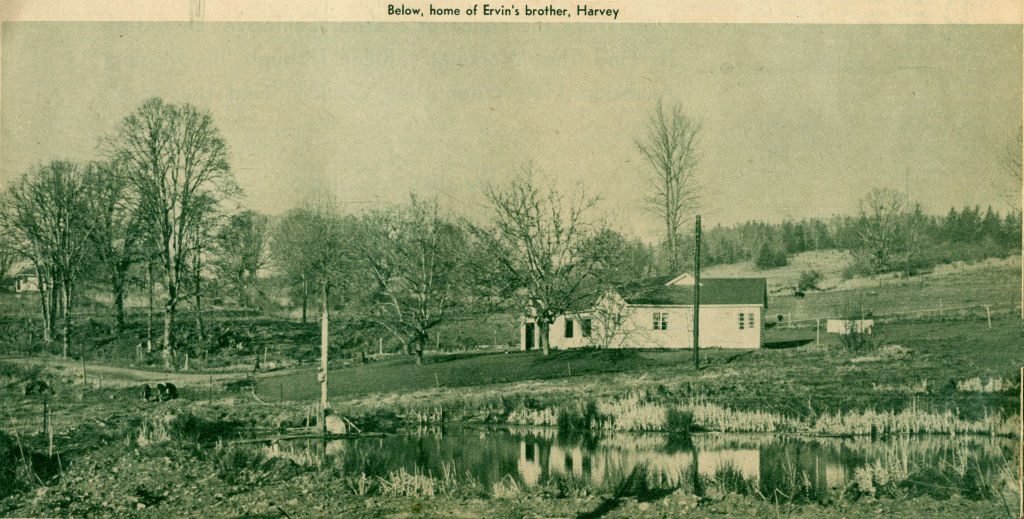
The officers drove back to Evergreen to talk with Harvey Kaser. On the drive, they discussed possible angles.
“It sounds interesting, but when you analyze it, we don’t have much there,” Huffman pointed out. “The Overosses are divorced and everything is final. The only one with a motive from this would be Casper Oveross. And since everything is settled, his motive isn’t very strong.”
Harvey Kaser and his wife, Edith, were questioned about the possibility of a triangle existing between his brother and the Overosses.
“I think both Mary and Cap had some ideas about that,” Harvey declared. “I’m sure it wasn’t true, but Cap kept saying it until he got Mary to believing it.”
“Did your brother go to see Mrs. Oveross frequently?”
“We’ve all grown up together,” Harvey explained. “We’ve been friends since we were little kids. Ethel is my wife’s twin sister. We all live right here near each other and we’re bound to be good friends.”
“Whether there was any truth in it or not, could Casper Oveross have believed your brother was responsible for breaking up his marriage?” Huffman asked bluntly. “The truth would make no difference to a man blinded by jealousy.”
“Yes,” Harvey answered. “Cap blamed Ervin. I even heard that he threatened Ervin. But Cap was born right down at Rocky Four Corners on Abiqua Creek. We’ve all been like one big family since we were kids.”
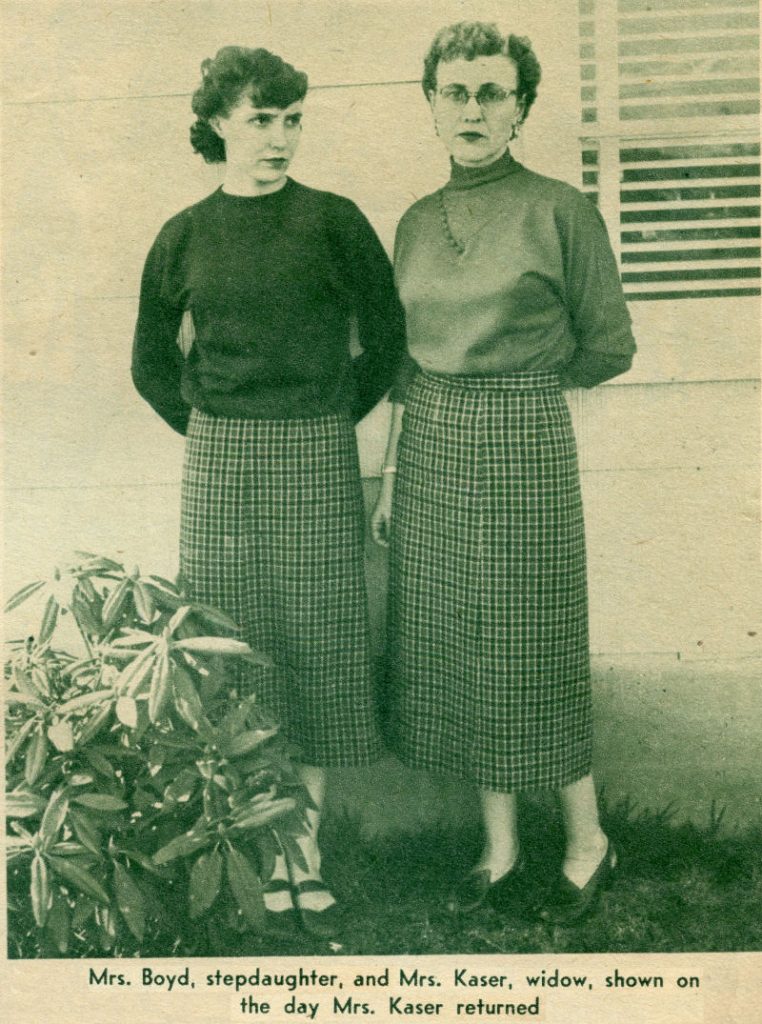
The officers next stopped to see Mrs. Oveross. She repeated what they had heard from Harvey Kaser. The suspicions concerning herself and Ervin Kaser, she declared, were unfounded.
But she did admit that the suspicions were held by both her former husband and Mary Kaser.
“I don’t see any reason, though, why Cap would still have it in for Ervin,” Mrs. Oveross declared. “our troubles have all been settled.”
Casper Oveross was found in a small cabin in Silverton, where he lived alone. The former farmer, who has a local reputation as a hunter and woodsman, had turned to carpentry after his divorce.
“I filed the divorce and I got it,” the slender, gum-chewing man told the officers. “But the judge gave her the kids and our home out at Evergreen. I got twenty acres near Abiqua Creek.”
“You were sore at Ervin Kaser,” Young said flatly.
“I’m not denying it,” Oveross replied. “I said he broke up my marriage. And I’ll say it now. He used to be my best friend. We’ve gone hunting and camping together and we were neighbors for about twenty years. But just because he’s dead is no reason for me to change my mind. I think he was a dirty skunk while he was acting like my friend.”
“We also heard you’re an excellent marksman,” Huffman said. “And I see you have a number of rifles.”
Cap Oveross tucked his plaid shirt tighter into the beltless top of his blue jeans and smiled. “I guess it’s natural I’d be suspected.”
“Where were you last night?”
“Right here.”
“Was anyone with you?”
“Nope. If I’d known somebody was going to kill Ervin, I’d have invited half the town in so’s I could have had a good alibi. But I didn’t know it.”
Oveross gave the officer the three hunting rifles that he owned so they could be test fired at the Crime Laboratory. “These are all my guns,” he said. “I never owned a thirty.”
“Who do you think killed Ervin?” Young asked Oveross. “You knew him well. Maybe you can help us.”
Cap chomped on his gum for several seconds. Looking squarely at the Sheriff, he said: “Let me put it this way. I don’t know who killed Ervin, but to be truthful with you, even if I did I reckon I wouldn’t tell you. In my book,he got what was coming to him.”
Meanwhile, additional patrolmen brought into the area by Huffman were aiding the Sheriff’s deputies in searching the entire area around the Evergreen district on the theory that the slayer might have disposed of the death weapon in one of the many ponds, creeks and wells in the district.
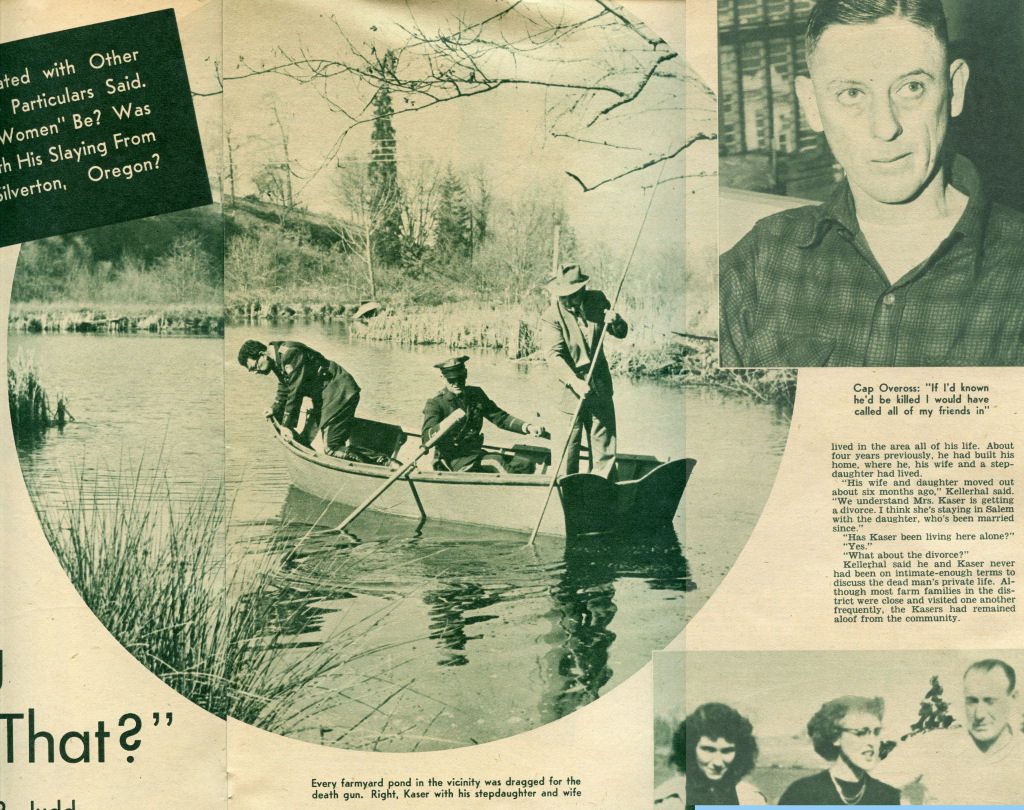
Ponds had been dredged on almost every farm to collect the Winter rain and hold it to water the cattle in Summertime. Rowboats, carrying officers with grappling hooks and magnets, covered all the ponds along the road from Silverton to Stayton, in the direction Kellerhal had seen the killer’s car take from the slaying scene.
The poker-playing pals of Kaser were questioned. No game had been planned for the night Kaser was slain. All denied that any arguments had cropped up during the card games that would provide a motive for the killing.
At the request of Sheriff Young, those who had been at the poker parties surrendered their rifles for ballistics examination.
Numerous other acquaintances of Kaser were asked to turn in their guns for the ballistics test.
Sam Lord was located at The Dalles. He readily admitted that he and Kaser had had violent differences concerning the job and payment for the work Kaser had hired him to do. But Lord had an airtight alibi of being in The Dalles at the time Kaser was killed.
The rural community seethed with excitement over the first slaying that ever had been committed in that area. Rumors kept the officers busy investigating leads that all eventually petered out to be only gossip.
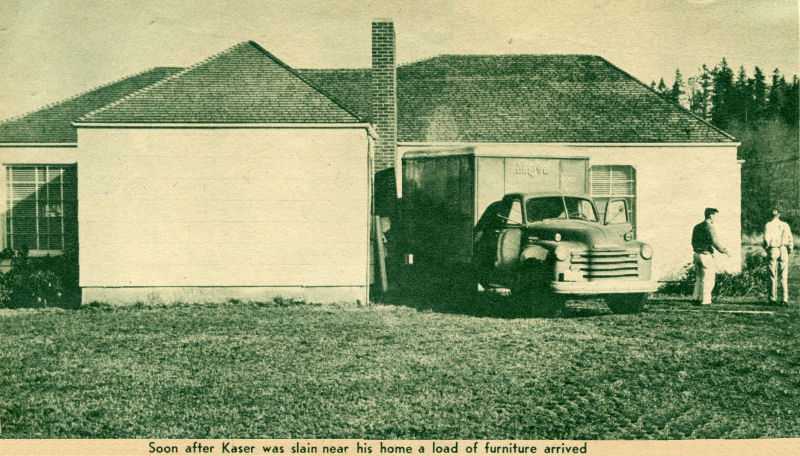
On Sunday afternoon, Mrs. MaryLouisa Kaser moved into the farmhouse where her husband had been slain. This started more rumors, but the widow explained that she was the sole heir of her husband’s estate and she intended to live at the farm.
Funeral services were conducted for Ervin Kaser in Silverton at two o’clock on Monday afternoon. The town was jammed with ranchers who put aside their farm tasks and came dressed in their Sunday best to pay their last respects. So many persons attended the services at the funeral home that a loudspeaker was placed outside the chapel so the huge crowd gathered on the lawn and in the street could hear.
But no arrest had been made.
The newspapers from Salem, which carried daily headlines on the slaying, had been hounding Sheriff Young, District Attorney Brown and Sergeant Huffman for facts on the progress of the case.
Young gave out a statement that made new headlines on Monday afternoon. The story quoted him as saying the officers had a suspect and as soon as a certain piece of evidence was uncovered, an arrest would be made.
When the other officers questioned Young about the story, he told them: “It’s half true. The piece of evidence we’re looking for is the gun.”
“How about the suspect?”
“I’m hoping the killer will see that and run. We’ll keep our eyes open. If anyone leaves the area in a hurry it could be the slayer thinking we are getting close to him.”
But no one ran.
Search for the rifle used to kill Kaser continued, for both Young and Huffman felt certain the slayer would attempt to get rid of the damning evidence.
“Whoever it is, he knows we have the slugs that can prove it’s the death weapon,” Huffman reasoned. “And he’s smart enough to conceal it because he took pains to make sure the cartridge casings couldn’t be found.”
“And the the chances are he got rid of it shortly after he killed Kaser,” Young added. “He’d know we’d put up road blocks. The logical place would be in one of the ponds or creeks near the Kaser farm.”
Deputy Shaw said: “We’ve just about covered all of them. But if he took time out to bury it, he may have us whipped. We’ll only get it if somebody should stumble onto it.”
One strong clue to the slayer was the tight grouping of the rifle shots into the car. Only an expert marksman could make a pattern so small. Oveross was an expert marksman: the officers investigated him as closely as they could Tuesday morning. A neighbor near the farm Oveross owned at Abiqua Creek reported that Oveross had a rifle range on his property.
“I’ve seen Cap out there practicing the past few weeks,” this neighbor said. “He’s been using up a lot of ammunition and it’s a long way until hunting time. Maybe you’d better ask him about it.”
Before requestioning Oveross, the officers went out to the farm to look over the rifle range. It had a number of old logs as backstop for the bullets.
Criminologist Prouty carefully dug some of the spent slugs from the logs. He came up with several he identified as .30 caliber.
“Cap told us he didn’t own a thirty-caliber rifle,” Young said. “those three guns he gave us were of a different size than this.”
The slugs from the rifle range were rushed to the State Crime Laboratory where they were put under a comparison microscope with the spent bullet found in Kaser’s car and the one removed from the body. Enlarged photographs were made so that every mark on the lead could be examined closely.
“I have found enough similarity in the samples to indicate that the bullets taken from the rifle range might have been fired from the same gun used in the killing,”an expert declared.
Was it enough to charge Oveross with the slaying?
“We have a motive,” Young explained to District Attorney Brown. “Cap thought Ervin had broken up his marriage. We have the evidence of the slugs.”
“I’ll issue a warrant,” Brown said. “we can bring him in and see what he says about it. But, of course, we can’t prove yet that Oveross owned such a gun. Anybody could have used his range.”
Oveross was arrested at the home of a relative.
“You guys are nuts,” Oveross told the officers. “I didn’t kill Ervin. I’ll admit I think he deserved killing, but I didn’t do it.”
Told about the slugs found at the rifle range on his farm, Oveross said: “I don’t know nothing about ballistics. Maybe you can tell if a gun shot a certain bullet.But it don’t mean it was my gun, or I did the shooting.”
“You were seen out there practicing.”
Calmly chewing gum, Oveross shrugged. “Sure, I shoot all the time. It’s my sport. Some men play golf. Some men bowl. Me, I shoot. Anything wrong with that?”
“You are going to be charged with killing Kaser.”
“In that case, I guess I’d better keep my mouth shut,” Oveross said. “I know you got good reason to suspect me, so it’s no use me helping you any. All I’m going to tell you is I didn’t do it.”
District Attorney Brown announced that Oveross refused to take a lie-detector test and quoted him as saying: “I’m just going to sit tight. You can’t prove a thing.”
Brown filed a charge of murder against Oveross in the court of District Judge Edward O. Stadter,Jr., and called a special session of the Marion County grand jury to hear the evidence that had been collected.
On Monday, February 28, he summoned seventeen witnesses before the jury.
At the end of an all-day session, the jury ruled that Brown did not have sufficient evidence to indicate Oveross should be held to answer the charge in court. Brown withdrew the charge before the district court and Oveross was released.
Brown announced immediately, “If I get additional evidence later, I’ll call the grand jury into session again.”
Pressed by reporters for a further statement, he said: “We have no other suspects at this time. All I can say is that the Sheriff and the State Police will continue to work on the case until it is solved.”
What could be done?
“Find the gun,” Brown said.“Find the gun and we’ve got a case. It may not be against Oveross, but if you can find the gun, I can make a case against whoever owns it.”
In a rural district like Evergreen, nearly every farmer has several hunting rifles. The .30-caliber gun is a favorite for hunting.
A tedious canvass began of all sporting-goods stores in the area to find out if anyone had purchased a .30-caliber rifle recently. It was a nearly hopeless task, but no other leads were open.
The gun might have been bought locally, or it could have come from Portland or some other big city. It might have come from a mail-order house or even have been bought secondhand.
Weeks went by and the excitement in the rural community that had experienced its first slaying failed to subside. It was the prime topic of conversation at every gathering.
The curious still drove out on the the highway and paused to look at the house where the widow of Kaser was living and to examine with interest the spot where the slayer had waited in ambush to slay Kaser.
Rumors grew rather than died as time lapsed. Sheriff Young and Sergeant Huffman constantly were investigating some new angle that was brought to them because of talk in the area.
Then, on Sunday, May 8, Larry Wacker, a Parrish Junior High School student, and two chums, Neil and Roger Beutler, were fishing in the Pudding River not far from the junction of the Pratum-Silverton-Sublimity roads, about five milesfrom Ervin Kaser’s farm.
Larry found a rifle in the river. An empty shell was in the chamber and a live shell in the magazine. The boys took the gun to the home of John Ross, where their parents were visiting. The Sheriff was notified.
Young asked the boys and their parents to make no mention of the rifle until he was ready to release the news.
The gun was rushed to the State Crime Laboratory. Ballistics tests, according to the police, gave definite proof it was the rifle that had fired the slug that killed Kaser.
Next came the serial numbers on the gun. Could it be traced to the last owner – the person who had used it for a killing?
The factory was called. Records there supplied the name of the wholesaler in Portland who had received it, way back in 1948.
The wholesaler had a record of the dealer to whom it had been shipped.
The hardware store dealer did not have a record of the purchaser of the serial number of the gun. (Records are required only on handguns.) But the owner of the store recalled that he had received only two guns of this caliber and model during that entire year, since the wartime shortage of sporting guns still existed then.
He had sold both of these guns shortly after he had received them in Jarnuary of 1949. One of the purchasers, according to the police, had been Casper Oveross.
Young first questioned the man who had purchased the second rifle. This man still had his gun.
Casper Oveross had disappeared from Silverton. After being freed from the murder charge by the grand jury, he had announced he was going to Southern California to work. He was believed to be in Santa Barbara.
District Attorney Brown once again called a session of the grand jury. He presented the evidence including the new facts about the gun and this time the jury, on May 16, returned an indictment charging Oveross with the murder of Kaser.
An all-out search was started for him. On May 21, the Territorial Police in Fairbanks, Alaska, located Oveross working as a carpenter on a construction job. He was arrested on a bench warrant issued from Salem, Oregon, charging him with first-degree murder and unlawful flight to avoid prosecution.
“I didn’t even know they wanted me again,” Oveross said. “I wasn’t running away, I just happened to land a good job in Alaska. I told them once I wasn’t guilty, but I guess they won’t be satisfied until I go to trial and prove it.”
At the present time, Oveross has been returned to Salem from Alaska and is being held in custody pending further legal action. Watch the department entitled “Up to the Minute” in a future issue for the results of this action.
The names of Ray Jackson, FredBarto and Sam Lord in this story are fictitious.
Next up: True Police Cases
Blogically yours,
Everett
